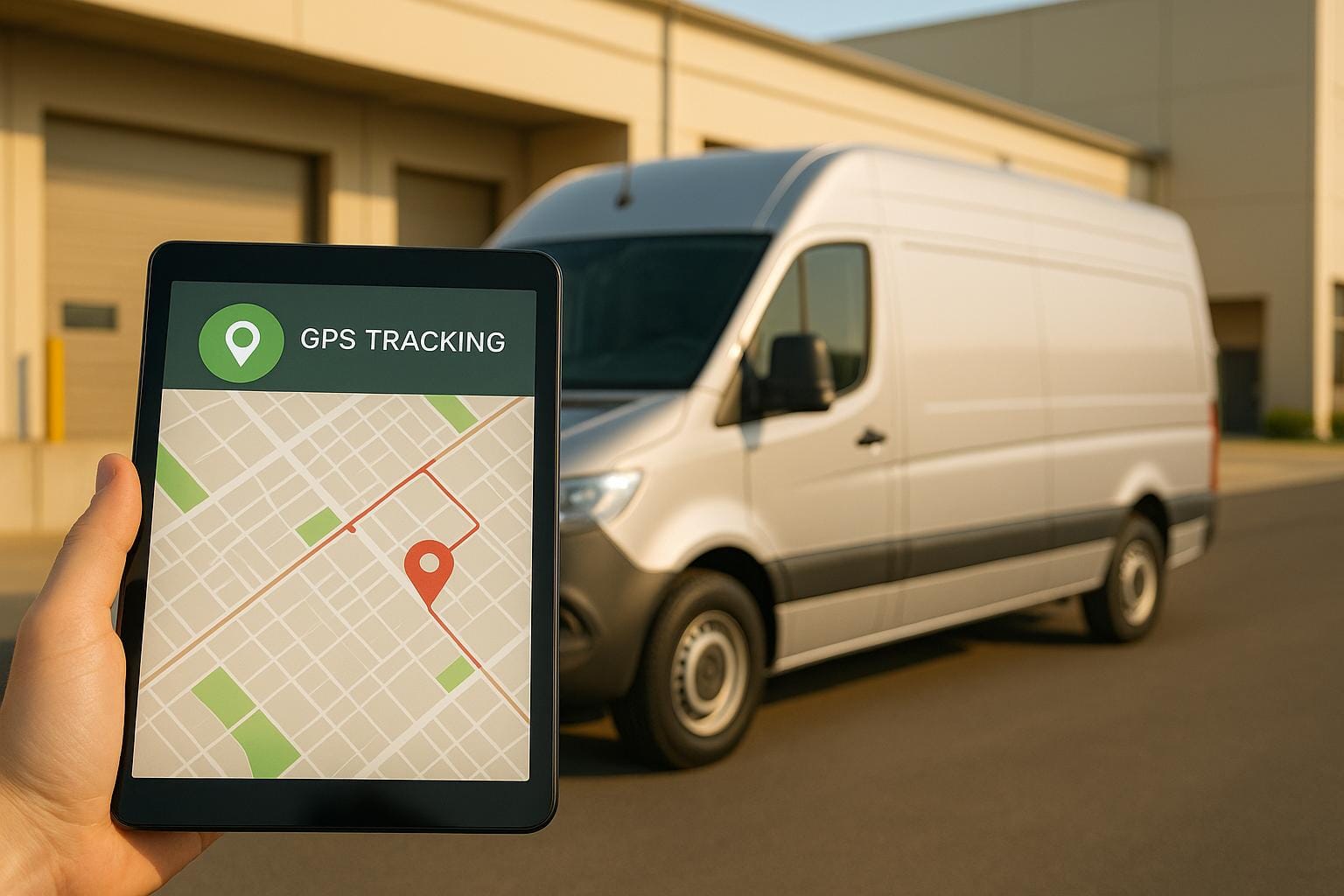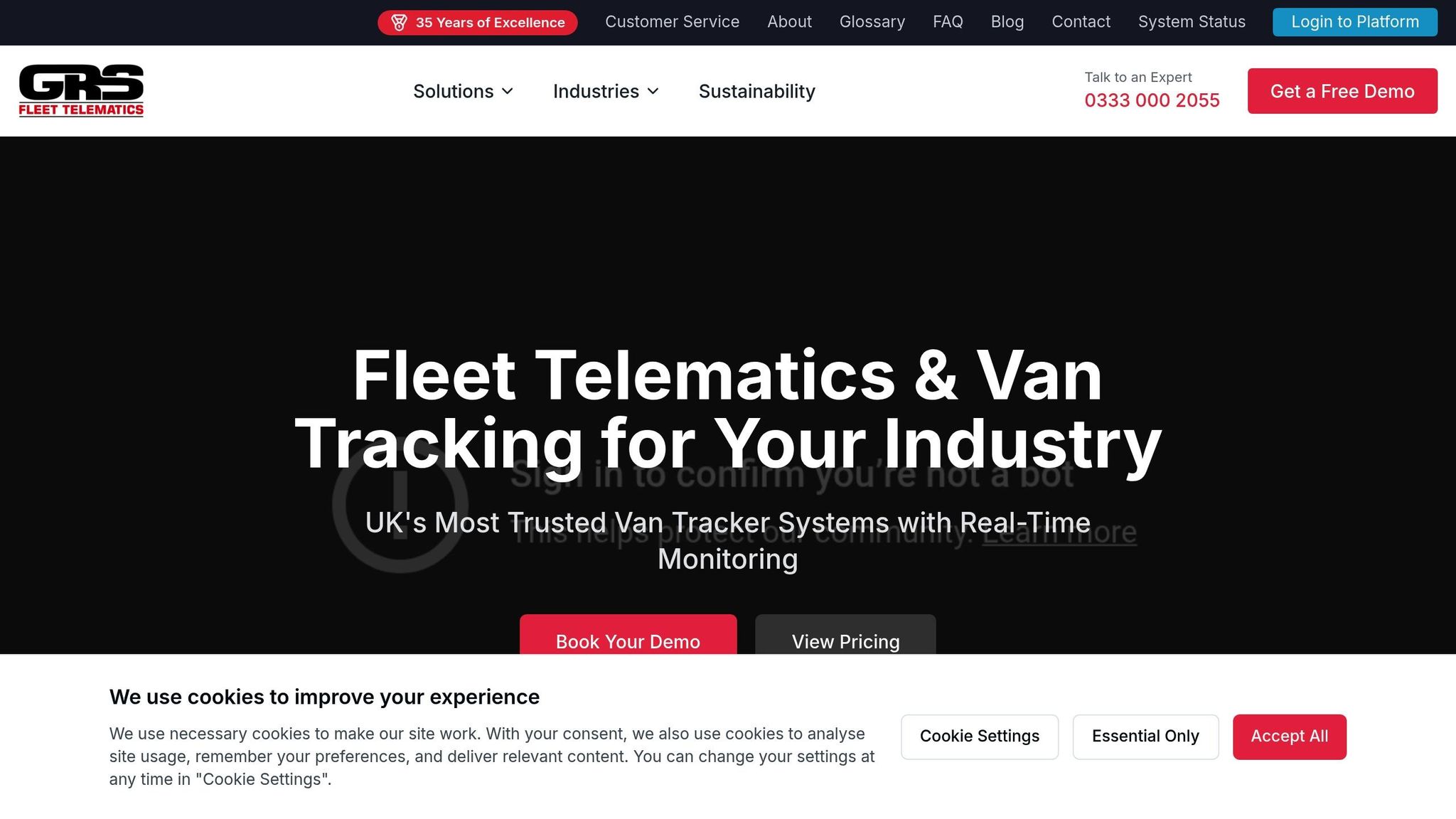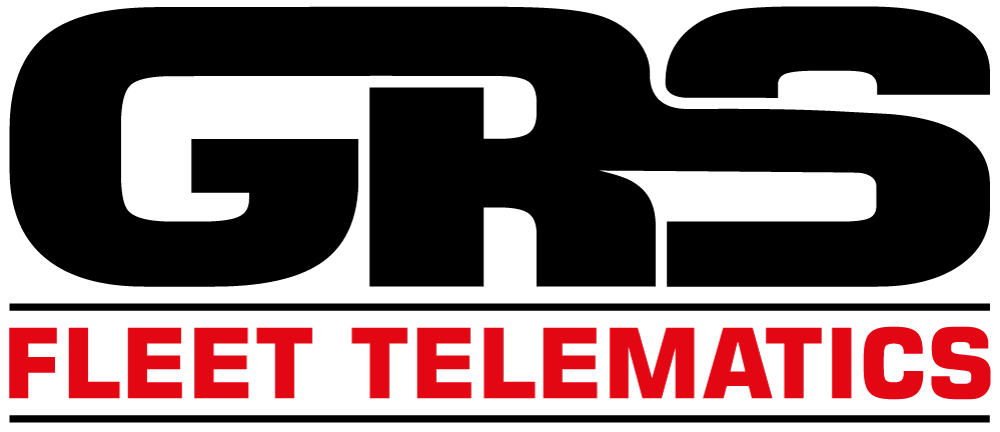Van Tracking vs. Traditional Delivery Monitoring
Explore how modern van tracking systems outperform traditional delivery monitoring, enhancing efficiency, security, and customer satisfaction for UK businesses.

Modern van tracking systems have completely changed how UK businesses manage deliveries. Unlike older methods, which relied on manual logs and phone calls, these systems use GPS, IoT sensors, and cloud-based software to provide real-time updates on vehicle location, driver behaviour, and fuel usage. Over 65% of UK fleet operators now use telematics, and this number is rising fast, driven by the need for efficiency, better security, and cost control.
Here’s what you need to know:
- Traditional Monitoring: Relied on manual processes, paper logs, and phone updates. It was slow, prone to errors, and lacked visibility.
- Modern Van Tracking: Offers live GPS tracking, route optimisation, digital proof-of-delivery, and automated alerts. It reduces admin work, improves safety, and enhances customer satisfaction.
- Security: Features like geofencing, dual trackers, and remote immobilisation significantly reduce theft risks and improve recovery rates - 91% for some systems like GRS Fleet Telematics.
- Efficiency: Automated tools cut costs by saving fuel, reducing delays, and simplifying compliance with UK regulations.
Quick Comparison:
| Feature | Older Methods | Modern Van Tracking |
|---|---|---|
| Real-time updates | Limited, slow | Continuous, live tracking |
| Delivery proof | Paper-based, manual | Digital, instant |
| Route planning | Driver-dependent, manual | Automated with real-time traffic |
| Security | Basic, reactive | Advanced, theft prevention tools |
| Admin workload | High | Minimal, automated reports |
Modern tracking systems are a better solution for businesses looking to save costs, improve service, and protect assets.
What is Telematics? (and How Can it Help Your Fleet?)
Traditional Delivery Monitoring Methods
In the past, many UK businesses depended on manual record-keeping and phone calls to keep tabs on their delivery operations. These methods focused on tracking deliveries after the fact, rather than providing updates in real-time. As a result, fleet managers had limited insight into what was happening on the ground at any given moment.
How Traditional Methods Worked
Traditional systems revolved around manual processes. Drivers would jot down delivery times, note customer confirmations, and log any route issues on paper. Communication with dispatch teams relied on phone calls or radio systems to share updates or report problems throughout the day. This heavy reliance on manual documentation often created bottlenecks in operations.
Challenges of Traditional Methods
These older systems came with their fair share of drawbacks. Without real-time data, businesses faced delays in updating vehicle locations or statuses, making it harder to address customer queries or operational hiccups quickly. Manual record-keeping also left room for human errors - whether it was incorrect entries or misplaced paperwork - making it harder to verify performance or resolve disputes. On top of that, the administrative burden of processing and reviewing these records slowed things down even further. The inefficiencies of these methods highlighted the need for more modern solutions, paving the way for real-time van tracking technologies.
Modern Van Tracking Systems
Modern van tracking systems have revolutionised how UK businesses oversee their delivery operations. By integrating GPS technology, IoT sensors, and cloud-based software, these systems provide a continuous flow of data, offering fleet managers unparalleled insight into their operations. Unlike manual tracking methods, these systems work automatically, transmitting data via satellites and mobile networks. This enables fleet managers to access real-time updates from any internet-enabled device, whether they’re at their desk or on the go. With this technology, delivery operations can be fine-tuned for maximum efficiency.
Main Features and Functions
Real-time GPS Tracking
These systems allow fleet managers to monitor vehicle locations with pinpoint accuracy. Live maps display each van’s position, speed, and direction, providing constant updates that make it easy to track progress and stay informed.
Telematics and Driver Performance Monitoring
Telematics tools gather and analyse data on fuel usage and driver behaviour. Metrics like harsh braking, rapid acceleration, and excessive idling are tracked, helping businesses improve safety standards and encourage eco-friendly driving habits.
Route Optimisation
Advanced route planning software identifies the quickest and most efficient paths by factoring in real-time traffic, road closures, and delivery schedules. If delays arise, the system recalculates routes instantly, helping drivers avoid congestion and stick to deadlines.
Digital Proof-of-Delivery Systems
Gone are the days of paper logs. Drivers can now use smartphones or tablets to capture customer signatures, photos, and notes. This information is uploaded instantly to a central system, providing immediate confirmation and streamlining the delivery process.
Automated Alerts and Notifications
Custom alerts keep fleet managers informed about critical events. Whether it’s a vehicle breaking down, speeding, or crossing a geofence boundary, notifications via email, SMS, or app ensure swift action can be taken.
Geofencing Technology
Geofencing creates virtual boundaries around specific locations such as depots, customer sites, or restricted zones. The system logs and notifies managers when a vehicle enters or exits these areas, ensuring compliance with operational guidelines and confirming key milestones like arrivals and departures.
Advantages for UK Fleets
The benefits of these systems are clear. By addressing inefficiencies and enhancing security, modern van tracking technology provides UK fleets with tangible advantages. For instance, identifying poor driving habits can lead to noticeable fuel savings, while accurate delivery estimates and proactive delay notifications improve customer satisfaction. These tools not only reduce complaint volumes but also boost the overall reputation of a business.
Automating record-keeping and reporting makes compliance with UK regulations much simpler. Accurate logs of driver hours and vehicle maintenance ensure businesses remain on the right side of the law without the administrative burden.
Security is another area where these systems shine. Companies like GRS Fleet Telematics enhance protection with dual-tracker technology, which uses both primary and secondary devices to prevent thieves from disabling monitoring. With a 91% recovery rate for stolen vehicles, this technology offers peace of mind and robust asset protection.
Additionally, detailed reports on fuel consumption, vehicle maintenance, and driver performance help fleet managers identify inefficiencies and optimise resources. The cloud-based nature of these platforms means they can easily scale with a growing business, while integration features ensure they work seamlessly alongside existing software systems.
Efficiency Comparison: Van Tracking vs Traditional Monitoring
Modern van tracking systems have transformed how businesses manage deliveries, leaving traditional methods in the dust. While older approaches rely heavily on manual processes - slowing response times and increasing administrative workloads - modern tracking leverages automation and real-time data to simplify daily operations.
Side-by-Side Comparison
| Factor | Traditional Monitoring | Modern Van Tracking |
|---|---|---|
| Real-time Visibility | Limited to scheduled check-ins via radio or phone calls | Continuous GPS tracking with live location updates |
| Route Optimisation | Manual planning based on driver knowledge | Automated route calculation using real-time traffic data and dynamic adjustments |
| Delivery Verification | Paper-based proof requiring manual processing | Digital verification via electronic signatures or instant photo capture |
| Administrative Workload | High – involves manual data entry and paper filing | Minimal – automated reports and customisable dashboards |
| Customer Communication | Reactive – updates only when customers enquire | Proactive – automated notifications keep customers informed |
| Data Accuracy | Prone to human error with delayed or incomplete records | Improved accuracy through instant, automated data collection |
This comparison makes it clear: modern tracking systems are reshaping efficiency and cutting costs. Automated alerts ensure swift issue resolution, enhancing service quality. For example, real-time notifications flag problems immediately, allowing businesses to act quickly and maintain high standards.
The financial benefits are equally compelling. Traditional monitoring often leads to higher administrative costs, while modern tracking reduces overheads by automating repetitive tasks. Additionally, intelligent route planning curbs unnecessary mileage, saving on fuel and improving overall fleet performance.
UK Case Study Examples
Many UK businesses have already embraced van tracking technology to boost efficiency across various industries. Take parcel delivery services, for instance - GPS tracking has improved delivery schedules and strengthened customer communication. In the construction and trade sectors, precise tracking has enabled tighter delivery windows, ensuring reliability and better service.
In time-critical industries like emergency services, modern tracking takes coordination to the next level. By identifying the nearest available vehicle and providing optimised routes in real time, these systems help teams respond faster. The result? Improved service delivery, cost savings, and more streamlined fleet management.
A great example of this technology in action is GRS Fleet Telematics. Their dual-tracker system boasts an impressive 91% recovery rate for stolen vehicles and is available for as little as £7.99 per month. This affordable solution ensures even small UK businesses can access cutting-edge tracking while maintaining top-notch security and operational efficiency.
Security and Risk Management
For fleet operators, security has always been a tough nut to crack. Traditional approaches often leave businesses exposed to risks. Enter modern van tracking systems, which shift the narrative from merely reacting to threats to actively preventing them.
Theft Prevention and Vehicle Recovery
When it comes to vehicle theft, traditional delivery monitoring systems fall short. Once a van is stolen, the process of filing police reports and making insurance claims can drag on, causing major disruptions to operations.
Modern van tracking systems change the game. With GPS monitoring providing real-time updates, stolen vehicles become significantly harder to hide. Fleet managers receive instant alerts if unauthorised movement is detected, allowing them to act quickly.
Technologies like dual-trackers and geofencing add even more layers of security. Dual-trackers ensure continuous monitoring, even if one tracker is disabled, while geofencing triggers alerts if a vehicle moves outside designated areas. Together, these tools greatly improve the chances of recovering stolen vehicles.
For example, GRS Fleet Telematics reports a 91% recovery rate for stolen vehicles - a stark contrast to traditional methods. Add immobilisation features to the mix, and you’ve got a powerful deterrent. Fleet managers can remotely disable a stolen van’s engine, preventing further movement and making recovery efforts much easier.
Now, let’s explore how these systems go beyond theft prevention to ensure compliance and protect sensitive data.
Compliance and Data Security
Modern tracking systems don’t just protect vehicles - they also safeguard data and streamline compliance. Unlike traditional methods that rely on manual record-keeping, these systems automatically create detailed digital audit trails. Every journey, stop, and driver action is logged with precise timestamps and location data, making compliance reporting straightforward. This also provides solid evidence for insurance claims or legal disputes.
Data security is another key strength. Advanced encryption protocols protect sensitive information, such as location data and driver records, from cyber threats. These systems are designed to meet strict UK data protection standards, ensuring peace of mind for fleet operators.
Driver behaviour monitoring adds another layer of security and compliance. Alerts for speeding, harsh braking, and unauthorised vehicle use help maintain professional driving standards while reducing liability risks.
Additionally, 24/7 monitoring ensures round-the-clock vigilance. Professional monitoring centres track fleet movements continuously, offering immediate responses to any security incidents - something traditional methods simply can’t match.
For businesses looking to maintain their branding while accessing these advanced features, white-label solutions are available. These allow fleet operators to present tracking capabilities under their own brand, bolstering customer trust and loyalty.
GRS Fleet Telematics offers flexible tracking options, including dual-tracker technology and immobilisation features, with prices starting at just £7.99 per month. With a 91% recovery rate, it’s a small price to pay for peace of mind.
GRS Fleet Telematics: Advanced Solutions for UK Businesses

GRS Fleet Telematics goes beyond basic tracking by combining real-time data with proactive security features. With decades of industry expertise, it offers tailored solutions specifically designed to meet the needs of UK businesses. Let’s take a closer look at the hardware options and service benefits on offer.
Features and Pricing
GRS Fleet Telematics provides three hardware packages, catering to different security priorities and budgets:
- Essential package (£35): A single wired tracker for real-time vehicle monitoring.
- Enhanced package (£79): Includes a primary tracker and a secondary Bluetooth backup, utilising dual-tracker technology with a 91% recovery rate.
- Ultimate package (£99): Builds on the Enhanced package by adding remote immobilisation, allowing vehicles to be disabled if necessary.
Each package comes with a £7.99 per vehicle monthly software subscription. This covers SIM data, dedicated account management, and full platform access, making advanced tracking tools accessible to businesses of all sizes - from small operations with a single van to large-scale fleets.
The service also includes driver behaviour analytics, tracking metrics such as speeding, harsh braking, and eco-driving. These insights can help UK companies improve fuel efficiency by up to 12%. Additionally, white-label options allow businesses to maintain their branding while utilising the tracking features. Free installation is available when paired with fleet branding services, and the pay-per-recovery model eliminates upfront recovery fees, offering flexibility and cost savings.
Meeting UK Business Requirements
UK businesses face specific challenges like rising vehicle theft, increasing fuel costs, and stringent compliance regulations. GRS Fleet Telematics addresses these issues with advanced features that go far beyond traditional monitoring systems.
Round-the-clock monitoring ensures continuous oversight, supported by UK-based customer service teams ready to provide rapid technical assistance - even during off-hours or emergencies. This is especially beneficial for industries requiring 24/7 operations.
Automated compliance tools simplify regulatory reporting by creating detailed digital audit trails. Every journey, stop, and driver action is recorded with precise timestamps and location data, ensuring businesses meet UK compliance standards. Advanced encryption safeguards sensitive information, aligning with strict data protection laws.
Real-time fleet visibility provides instant alerts for unauthorised movements, route deviations, or emergencies. This capability enables swift responses to operational challenges, helping businesses maintain service quality, reduce delays, and improve customer satisfaction.
Finally, the system is designed to grow with your business. As fleets expand, additional vehicles can be integrated seamlessly without the need for a complete system overhaul. These features not only protect your assets but also deliver measurable cost savings, with reduced fuel expenses and better vehicle utilisation often offsetting subscription costs within the first year.
Conclusion
The move from older delivery monitoring methods to cutting-edge van tracking systems marks a major shift in how UK businesses handle their fleets. Traditional approaches simply can’t offer the real-time updates and in-depth insights that modern tracking systems bring to the table.
Today’s tracking solutions provide instant vehicle locations, detailed driver analytics, and automated compliance features that far surpass the capabilities of older methods. They also enhance security with features like theft prevention, vehicle immobilisation, and quick recovery - tools that traditional systems just don’t have.
For UK businesses grappling with rising costs and growing security challenges, the advantages of modern tracking systems are hard to ignore. These systems help cut fuel costs, optimise vehicle usage, and ensure compliance with regulations through detailed audit trails. Plus, the ability to react immediately to route changes, unauthorised use, or emergencies gives businesses a clear edge over competitors still relying on outdated methods. This blend of operational efficiency and security makes modern tracking a game-changer for fleet management.
GRS Fleet Telematics is a strong example of how these advanced solutions meet the specific demands of UK businesses. With recovery rates that highlight robust security features and pricing starting at just £7.99 per month, their platform proves that advanced fleet management tools are within reach for businesses of all sizes. Offering 24/7 monitoring, UK-based support, and scalable options, GRS ensures that companies can safeguard their assets while streamlining operations. This shift from older methods to modern van tracking is essential for businesses striving to stay ahead in last-mile delivery.
Modern tracking systems clearly outshine traditional methods in accuracy, security, and cost-efficiency for UK fleets.
FAQs
How do modern van tracking systems make deliveries more efficient than traditional methods?
Modern van tracking systems have revolutionised delivery operations by offering real-time location tracking. This technology allows businesses to adjust routes on the fly, cutting down travel time, saving on fuel, and ensuring deliveries are handled with greater efficiency.
Beyond tracking, these systems streamline fleet management by automating tasks and analysing data. This leads to better scheduling, faster response times, and a noticeable boost in overall performance. The outcome? A seamless and dependable delivery process that benefits both businesses and their customers.
What security measures do modern van tracking systems provide to protect against theft and aid recovery?
Modern van tracking systems come equipped with cutting-edge security features to protect your vehicle and assist in quick recovery if it’s ever stolen. These systems include real-time location tracking, which lets you monitor your van's movements at any time, and geofencing alerts, which notify you if the vehicle crosses a predefined boundary. Additionally, tamper detection warns you of any unauthorised attempts to interfere with the system.
Some systems go a step further with remote immobilisation, enabling you to disable the vehicle remotely, making it much harder for thieves to make off with it. These features not only boost vehicle security but also provide businesses with added reassurance.
How can businesses in the UK stay compliant with regulations when using van tracking systems?
To comply with UK regulations, businesses must obtain explicit consent from drivers or vehicle owners before installing tracking systems in vans. It’s crucial to clearly communicate the purpose of tracking and explain how any collected data will be used. Tracking should only serve legitimate purposes, such as boosting fleet efficiency or improving security measures.
Moreover, all data collected must be managed in accordance with UK data protection laws. This means storing it securely and using it responsibly. While it’s illegal to track private vehicles or individuals without their consent, tracking company-owned vehicles is allowed - provided that drivers have been properly informed.
